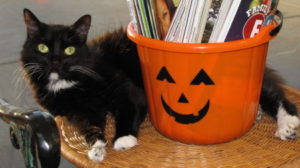Happy Halloween! Tonight emergency clinics around the country will be busy with sick animals. Unfortunately, Halloween is not all fun and games. Candy designed for human consumption is a big problem. Chocolate is toxic for dogs and cats. While cats seldom eat chocolate, dogs love it. I treated a cocker spaniel who ate a two pound box of chocolate. The puppy required three days of hospitalization but survived. In large doses it can prove fatal. Another problem is sugar free chewing gum and candy that contains xylitol. As little as one stick of chewing gum may cause a fatal drop in blood sugar in a ten pound dog. Thank goodness cats are resistant to the effects of the sugar substitute.
Electrocution and burns are another hazard. As the popularity of Halloween rises, so do the number of cord bites especially in young animals. When decorating, keep cords away from your pets. Also, think about your pets when decorating with candles. I see a lot of singed whiskers after Halloween.
Accidental escape is another tragic event on this night. With all the festivities, it is easy to leave a gate or door open. Confine your pet to a safe room or crate until the trick-or-treating is over. This is especially true with black animals. I have seen some horrific animal abuse to black animals at Halloween.
Lastly, Operating Rooms will be busy removing foreign bodies during the next few days. Decorations and costumes are the likely culprits. Again, confine your pet to a safe room or crate to prevent this from happening.
The photogenic feline pictured above is Sox. She is a lucky girl for two reasons. First, she was adopted by The Animal Hospital at Tatum Ranch after suffering a spider bite that required extensive surgical intervention. Dr. Anger performed multiple procedures to debride and reconstruct her rear end. Second, the hospital is set up to keep her safe from all the problems listed above. Sox will spend her night curled up in bed, safe and sound. In the morning, she will resume her duties as the Animal Ambassador for the clinic. It is common for veterinary hospitals to have a “clinic cat”. The next time you visit your veterinarian, please take time to meet them. Their stories will amaze you.

